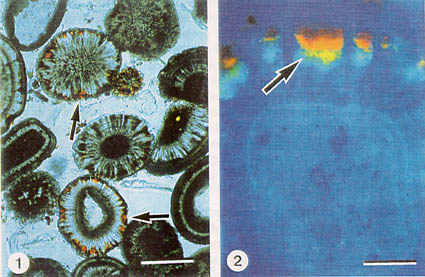

Photomicrograph
of ooid limestone. Grains
are 0.5-1 mm in size. Large grain in center
shows well developed concentric calcite layers.
carbonate and form limestones that look like layers of fish eggs. Ooids form in very shallow, warm water with
strong wave action (e.g. the Bahamas). A small fragment of carbonate (e.g. a piece of shell material) is sloshed
around by waves, calcite or aragonite is precipitated on this seed when it rests on the sediment surface, and then
the precipitate is rounded and smoothed by wave action. Repetition of this process leads to multiple concentric
layers. This, in esscence is the conventional view of carbonate ooids genesis, but recent research indicates that
organic matter and microorganisms may actually be involved in ooid formation. Some information on that issue is
provided below.
